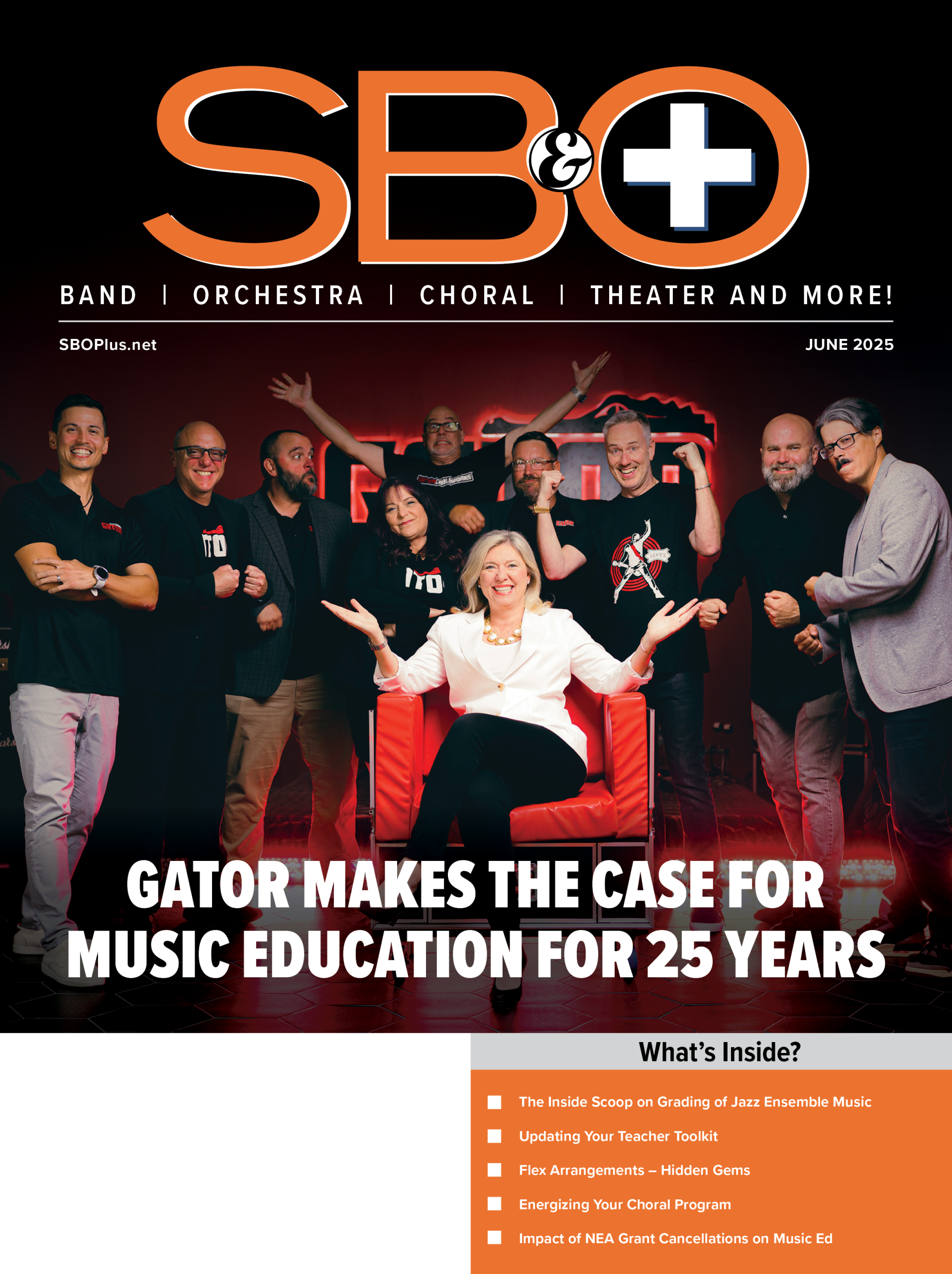A common misconception about teaching children to play the cello is that it requires more striving and effort than its smaller counterparts. Not true! Playing the cello requires more balance and preparation, more relaxation and use of natural body weight.
Avoid terms like “grip,” “push,” “press,” “hold,” “squeeze,” and “tight.” Substitute “good” words like “hang,” “drape,” “relax,” “draw,” “weight,” “breathe,” “balance,” and “hold.” Avoid the term “bow grip”; its very nature implies tightness. Use instead “bow hold.” A good tone is not produced by pressing harder, but by adjusting the location of the bow in relation to the bridge and using more arm weight.
A beautiful tone relies on the right combination of bow placement, bow speed, and arm weight. If notes are weak or squawking because the left hand is not in good contact with the fingerboard, squeezing or pressing the string down is not the answer. Advise students to hang their fingers from the fingerboard, as if they were hanging from a cliff by their fingertips. When shifting, emphasize the release of pressure from one position to the next. A shift should be executed by release of weightglide to the next position, and sink into the fingerboard upon arrival.
Correct instrument position is imperative for relaxed playing. The knees should be even with the points of the bottom bouts. Adjust the endpin to this height. The feet should be directly under the knees for optimum balance and posture. The top of the body of the instrument should rest as close to the breast bone as possible. The weight of the body should be thrown forward into the instrument. Cellists must sit on the edge of the chair – leaning backwards can cause back strain. The endpin should be angled about two to three inches to the right of center, ensuring that the scroll doesn’t hit the student’s head. The scroll should not be resting on the shoulder, but above the shoulder with the bottom peg close to the left ear. As the student grows, this position will change. A comfortable playing position is important. Keep trying!
The Thumb is the Secret
Bow hold. Hold the bow like a club in the right hand. Unroll the fingers and place the thumb at the edge of the frog and the middle finger directly across from it at the end of the tape/leather at the first knuckle. All other fingers support, hanging or draping over the bow at the first knuckle. The thumb should be curved and pointed toward the ceiling for maximum flexibility. (Of course this depends entirely upon the length of the student’s thumb.) When the bow is on the strings, try to keep the hand flat, except at the frog and tip where it will be angled slightly. The bow hold for cello is quite square, which provides good balance for the heavier bow.
Left Hand Position. For flexibility and balance, center the thumb under the second finger. I prefer to curve the thumb slightly, instead of flattening it against the back of the neck. This prevents the student from pressing up with the thumb to bring the fingers down onto the fingerboard. It is also an advantage when the student begins shifting – the thumb on its side is more slippery and can’t hold the hand in position by squeezing. Visualize hanging from a cliff by your fingertips. The weight to depress the strings comes from the arm weight pulling the string toward the fingerboard, not pressing from above. The thumb should be relaxed at all times, no squeezing. Visualize a ripe strawberry between the thumb and neck of the cello. Gently hold it there, but don’t crush it. Most hands require a slight adjustment for perfect intonation between fingers one and three in first position. The advanced player does this instinctively. This is best achieved with a slight rotation forward toward fourth finger and backward toward first finger, rocking like a see-saw around the balance point, which is the thumb.
Finding Third and Fourth Position. The left thumb is key for the secure location of these positions. Placing the thumb in the saddle (where the neck meets the body), the second finger will be directly across from it in open third position. In fourth position, the first finger will be across from the thumb.
Extensions. There are two distinct types of extensions on the cello: first finger backward and the forward extension, which moves the entire hand. The first is definitely the easier and should be taught first because it causes less strain on the student’s hand. (Unfortunately, most intermediate string literature uses sharp keys, and finding appropriate literature can be a problem).
Exercise. Picture the left hand as an elephant, with the forefinger being the trunk and the other fingers and thumb being the body. The elephant needs to extend the trunk in order to retrieve a peanut lying outside its cage. The thumb will stay under the second finger as the first finger rotates backward for the extension, to be immediately returned to closed position upon completion of the extension.
The forward extension is more complicated. This time, the elephant’s trunk is tied to a tree and the body is pulling away. The second, third, and fourth fingers move forward, the thumb following under the second finger. The position of the hand will be the same as asking a four-year-old his age, with fingers spread and thumb under the second finger. Another way to think of this is T-H-E: thumb, hand, elbow. The extended hand will be supported by the elbow, which will rotate slightly forward to support the weaker fourth finger. Again, upon completion of the extension, move the hand back to normal position. Another school of thought on the forward extension is that it should be taught as an actual half-step shift, moving the hand forward for the extension and back into closed position. If you are using tapes on the fingerboard, the third finger should cover the fourth finger tape, while releasing the weight on the first finger completely, using for balance and support the second finger in its new extended position. Unfortunately, this extension is taught very early in most of the string method books, I believe without adequate explanation. Done incorrectly and repeated incorrectly, it may cause tendon damage in young hands and serious tension problems. Let me emphasize again: this is not an extension of the fourth finger, but between the first and second fingers, which is the natural extension of the hand.
Thumb Position. Thumb position on the cello is actually easier and more comfortable than first position. When starting beginners, I place the thumb on the natural harmonic D and A, which divides the string exactly in half between the nut and bridge. They play “Twinkle” in thumb position, as well as first position, which would be in unison with the violins. The angle of the left hand changes as it moves up the fingerboard. In thumb position, the top of the hand is almost flat (unless you have a student with exceptionally long fingers, in which case, the hand will be angled slightly). The thumb itself should be relaxed and curved, with two strings placed under it above the first joint. The top string will be directly above the first joint. An octave is formed between the location of the thumb on the lower string and the third finger on the string above. Pay particular attention to the curve of the other fingers, making sure that the joints don’t collapse. The fingerings will resemble violin fingerings, with the thumb being the open strings. First tunes should remain within an octave, to get used to the position and to strengthen the fingers at this new angle (i.e., “Joy to the World,” “Twinkle,” “Lightly Row”). The thumb may be moved anywhere on the fingerboard, acting as a “capo” on a guitar, providing a “stop” from which other scales may be played. The fourth finger is rarely used in thumb position with the exception of advanced repertoire. When does the thumb come up on top of the fingerboard and when should it be left behind? This is a matter of comfort, as all hands have different stretching capabilities. As a general rule, the thumb is behind the neck in fourth position, moves around to the side of the neck for fifth, sixth, and seventh positions (that is, with the first finger on the natural harmonic) and then above that, would be on top of the fingerboard.
These few simple suggestions should help the young cellists in your orchestra play with more comfort and ease. The cello is a very natural instrument to play; there is no twisting like with the violin. If a student is experiencing pain, there is a problem with tension or position. The exercises above will aid in promoting relaxed, effortless playing.
Lynne Latham, founder of Latham Music, earned a B.M. and M.M. in cello performance from Miami University in Oxford, Ohio. She currently maintains a private studio of violin, viola and cello students in the Winston-Salem, N.C., area. She is also a freelance performer and a former member of the Greensboro Symphony Orchestra. She has served as a clinician for Cello Day Festivals in Virginia, Ohio, South Carolina, Georgia and California. Latham has served as a clinician for the 1997 North Dakota and 1998 Maine Educators Conventions, the Colorado ASTA Summer 2000 Workshop and the 2001 Indiana Music Educators Convention. She has also been adjunct faculty at Pfeiffer University in Misenheimer, N.C., teaching string methods and applied music studies. She is a past-president of North Carolina ASTA with NSOA and maintains memberships in MENC/MIC, the String Industry Council, Music Publishers Association and RPMDA.

























